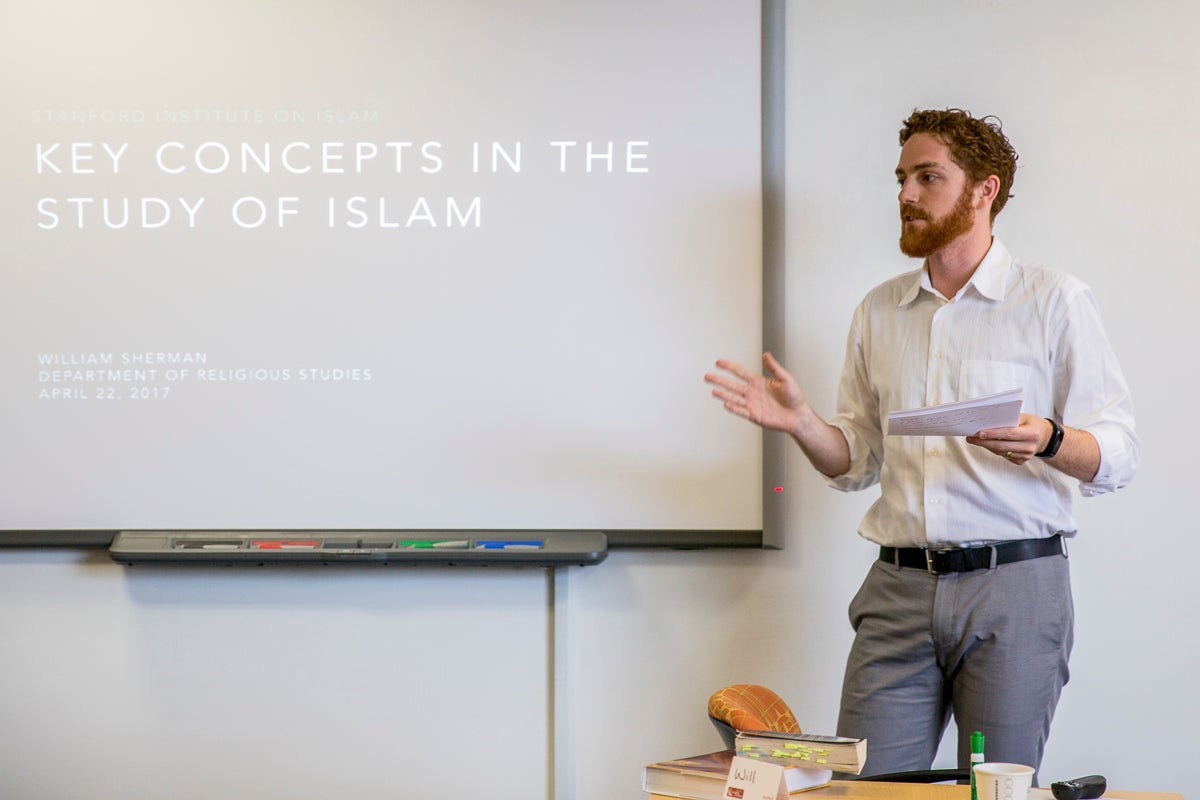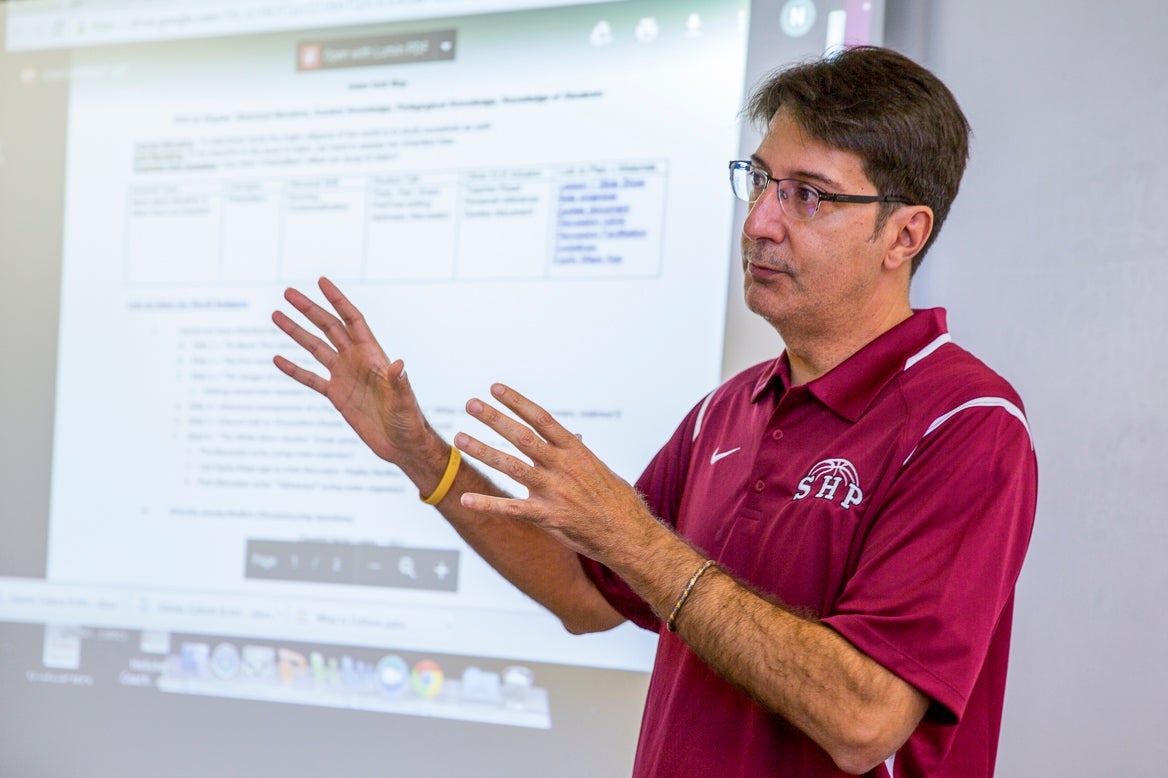A unique collaboration at Stanford is bringing a renewed focus to one of the world’s most followed but misunderstood religions.

Stanford doctoral student Will Sherman delivers the opening lecture of the Stanford Institute on Islam for Bay Area teachers. (Image credit: Jennifer Ray/CSET)
Stanford’s Institute on Islam, a collaboration involving the Abbasi Program in Islamic Studies, the Center to Support Excellence in Teaching (CSET) and Stanford Global Studies, held a five-week program this spring that provided Bay Area teachers innovative strategies to better educate students on Islam, the world’s second-largest religion with 1.8 billion followers.
The California State Board of Education’s History-Social Science Content Standards require Islam to be taught in the seventh grade (other major religions such as Christianity and Judaism are introduced in sixth grade). Islam is also covered in 10th grade as well as in some community college history and sociology courses.
Complex subject
Teaching Islam can be a complex and sensitive issue for educators because the religion is often mentioned in connection with terrorism and the Islamic State group.
The program’s goal is not to simplify the issue. History is messy, said Nicole Lusiani Elliott, professional development associate and instructional coach at CSET. Providing sanitized versions of history may be easier for teachers, she said, but not productive.
“A lot of our work is intended to avoid telling a single story of Islam,” Elliott said. “We’re exploring different aspects, considering different perspectives and addressing head on the problematic nature of teaching such a complicated faith and culture.”
The idea for the program began when Robert Crews, associate professor of history and the program’s former director, sought to create a program that would provide expert advice on Islam to secondary-school teachers, according to Shahzad Bashir, director of the Abbasi Program. Part of the Abbasi Program’s mission, said Bashir, “is to enhance the understanding of topics related to Islam and Muslims in the public sphere.”
Joining the initiative was Stanford Global Studies, which receives funding from the U.S. Department of Education’s Title VI grant program that is designed to strengthen, among other areas, “international studies teaching and research [and] professional development for teachers and faculty.”
While the Abbasi Program had the scholarly resources that could be beneficial to teachers, it did not possess the instructional means to equip educators. That’s where CSET came in.
“We have all these great scholars at Stanford, but they don’t necessarily have the pedagogical tools to translate all their knowledge into lessons for 15-year-olds,” Elliott said. “They came to us to do the pedagogy half. It’s been a really powerful partnership.”
Exploring Islam
The program explores four themes: Islam’s general tenets, the Islamic State and politics, Muslim refugees and immigration, and arts and gender. Stanford doctoral students presented lectures on these topics.
Will Sherman, a doctoral candidate in religious studies who delivered the opening lecture, said the teachers were “extraordinarily enthusiastic.” He also noticed some mild trepidation.
“There was some grappling,” said Sherman, “not with conceptual materials, but more with, ‘How do I bring this into the classroom?’ I think they were thankful to have this space where they could talk amongst themselves and share the same concerns.”

Scott McDade, a teacher at Sacred Heart Preparatory, delivers a presentation during the Stanford Institute on Islam. (Image credit: Jennifer Ray/CSET)
The program’s participants spread fairly evenly across middle schools, high schools and community colleges. Ryan Carothers, who teaches at Sunnyvale’s Peterson Middle School, enrolled to learn more creative ways to teach history. Carothers has a bachelor’s degree in history, specializing in Western civilization, which proved advantageous in designing projects and activities around that theme. But, Carothers said, “I found it was more difficult to be creative as we moved east.”
Carothers said he attended conferences at the Stanford Program on International and Cross-Cultural Education (SPICE), which offered innovative ways to present topics related to East Asia. He viewed the Institute on Islam as another resource to improve his teaching.
“Across the Islamic world, and across time, we find a great amount of complexity and variety,” Carothers said. “Our guest lecturers impressed every one of us by highlighting these nuances. When I teach my students about Islamic civilization, I hope to help them to see these differences. This means I might go beyond the simple set of architectural and artistic achievements covered in our textbook.”
Scott McDade, who teaches at Sacred Heart Preparatory in Atherton, said the program was “an excellent learning experience.”
“I have been teaching about Islam for quite a while,” said McDade, “but I find this program helps me to constantly reassess and refine my teaching.”
Fighting negativity
Although participants have lauded the program, Bashir said it still encounters skeptics.
“There were some negative comments made by individuals who seemed to think that the program was about giving an overly positive view of Islam, thereby avoiding critiques pertaining to terrorism, etc.,” Bashir said. “This is a misunderstanding of the purposes of the program and our intentions.
“If the critics had engaged us directly, we would have been happy to clarify that our purposes were not to proselytize or romanticize Islam, but to discuss complexities in terms of questions and answers regarding a phenomenon that spans the world and has a history of more than 1,400 years.”
While the program focused on teaching Islam, Elliott said the benefits for participants have been far greater.
“They all came because they want to learn more and have a deeper well of knowledge,” Elliott said. “They’ve each said in a variety of ways, ‘I came to learn about Islam, but I’ve learned so much more.’ That’s really meaningful for me to hear. We’re leveraging the greatness that’s offered here and bringing that to teachers who deserve it.”
The Islam Institute is one of several professional development opportunities for teachers offered through CSET and Stanford Global Studies. Two upcoming courses include First World War in a Global Context and History of the Americas: Mexican Revolution and Nation-Building, which will be offered July 31 to Aug. 4 during the Stanford Teaching Festival.